|
|
|
Sort Order |
|
|
|
Items / Page
|
|
|
|
|
|
|
| Srl | Item |
| 1 |
ID:
029172
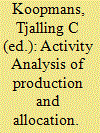

|
|
|
|
|
| Publication |
New Haven, Yale University Press, 1971.
|
| Description |
xiii, 404p.Hbk
|
| Standard Number |
0300015399
|
|
|
|
|
|
|
|
|
|
|
|
Copies: C:1/I:0,R:0,Q:0
Circulation
| Accession# | Call# | Current Location | Status | Policy | Location |
| 010389 | 658.500151972/ACT 010389 | Main | On Shelf | General | |
|
|
|
|
| 2 |
ID:
149898
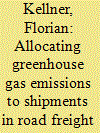

|
|
|
|
|
| Summary/Abstract |
The European Norm EN 16258 was published in 2012 to provide a common methodology for the calculation and declaration of energy consumption and greenhouse gas emissions related to any transport operation. The objective was to offer a pragmatic and scientifically-acceptable approach that allows a wide group of users to prepare standardized, accurate, credible, comparable, and verifiable energy consumption and emission declarations. However, in its current form, EN 16258 contains gaps and ambiguities, and leaves room for interpretation, which makes comparisons of supply chains difficult. This research aims to overcome the shortcomings in the domain of allocating emissions from road freight transport operations to single shipments. Based on a discussion of emission drivers and the results of numerical experiments comparing the allocation vectors created by the EN 16258 allocation rules with those generated by the Shapley value, which is claimed to be the benchmark, ‘distance’ is identified as the single most useful unit for bridging the trade-off between accuracy and simplicity better than the other recommended allocation schemes. Thus, this paper claims that future versions of EN 16258 should only allow the allocation unit ‘distance.’ This will promote the accurateness, simplicity, consistency, transparency, and comparability of emission declarations.
|
|
|
|
|
|
|
|
|
|
|
|
|
|
|
|
| 3 |
ID:
121311
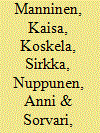

|
|
|
|
|
| Publication |
2013.
|
| Summary/Abstract |
Biogas production processes are often multifunctional systems, which also produce fertilizers from digested sludge. The environmental impacts of such systems are usually determined using life cycle assessment (LCA). There are alternative approaches to conduct the LCA, e.g., allocation of emissions based on a product's and co-product's energy content according to the Renewable Energy Directive (RED), or substitution without allocation according to the ISO 14040 standard. We calculated the climate change impacts of biogas production using these two alternative methods, whilst also considering process modifications of the base case biogas production process. The aim was to find out whether the production system achieves the saving targets for greenhouse gas (GHG) emissions set by the RED. Since the RED enables different interpretations of its calculation rules, we created four case studies representing alternative ways to allocate the emissions to the reject water and solid fractions separated from the sludge. Consequently, our emission estimates for the base case vary between 16.9 and 47.7 g CO2/MJ, while the emission savings range from 42% to 80%. Most of the case studies achieved the most stringent saving target (60%).
|
|
|
|
|
|
|
|
|
|
|
|
|
|
|
|
| 4 |
ID:
103346
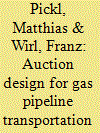

|
|
|
|
|
| Publication |
2011.
|
| Summary/Abstract |
As a response to the Russian dominance of the EU's natural gas supplies and the EU's increasing gas demands, major gas pipeline projects are currently under way to enhance the EU's energy supply security. Oftentimes to raise financing and to allocate gas transportation capacities, auctions are carried out to allow gas shippers to book transportation rights.
In recent years, auctions have emerged as one of the most successful allocation mechanisms in the microeconomic theory. However, different auction designs can lead to different outcomes making the choice of auction design a decisive one, especially for divisible-good auctions. This paper seeks to give a formulation of an optimal auction design for gas pipeline transportation capacity. Specifically three different mechanisms are tested: (i) NPV allocation; (ii) pro rata allocation; and (iii) optimization. In addition, Nabucco is taken as a case study to empirically show results of such auction designs.
Results show that a trade-off between revenue optimization and fair allocation can be observed: allocation per optimization is the favorable auction design when revenue maximization is more important than fair allocation. On the other hand, pro rata allocation is the auction design to be chosen when fairness of allocation is considered most central.
|
|
|
|
|
|
|
|
|
|
|
|
|
|
|
|
| 5 |
ID:
136188
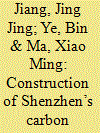

|
|
|
|
|
| Summary/Abstract |
The Shenzhen ETS is the first urban-level “cap-and-trade” carbon emissions trading scheme to operate in China. This paper gives an overview of the economic and emissions situation in Shenzhen and focuses on the development of the Shenzhen ETS regulatory framework. It is devised as an ETS with an intensity-based cap, output-based allocation and a market for trading of allowances. The design of the Shenzhen ETS attaches great importance to coordinate the dynamic relationships between economic growth, industrial transition and emissions control. The cap and its allocation are determined by carbon intensity reduction targets and economic output, with an aim to slow down emissions growth while mitigating shocks from economic fluctuation and industrial adjustment to market stability. The Shenzhen ETS features extensive coverage consisting of three types of regulated entities and four categories of covered emissions, in order to control carbon emissions by both improving energy efficiency and restraining growing energy demand. A competitive game theory method is created for allocation of free allowances to manufacturing enterprises. Mechanisms for carbon offsets and market stabilization are developed to promote active and orderly trading in the carbon market. Moreover, several challenges and their policy choices are detailed for the development of the Shenzhen ETS.
|
|
|
|
|
|
|
|
|
|
|
|
|
|
|
|
| 6 |
ID:
104173
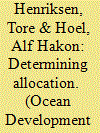

|
|
|
|
|
| Publication |
2011.
|
| Summary/Abstract |
This article discusses the allocation problem in international fisheries management, which is critical to effective resource management. A number of cases where allocation problems exist are reviewed and trends identified. It is concluded that power relationships between the states involved are an important determinant of allocation outcomes. While this may seem a frustrating conclusion, it nevertheless reflects the realities of international cooperation.
|
|
|
|
|
|
|
|
|
|
|
|
|
|
|
|
| 7 |
ID:
120116
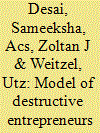

|
|
|
|
|
| Publication |
2013.
|
| Summary/Abstract |
The research on entrepreneurship as an economic phenomenon often assumes its desirability as a driver of economic development and growth. However, entrepreneurial talent can be allocated among productive, unproductive and destructive activities. This allocation has important implications in the developing world, particularly for countries hosting conflict or recovering from conflict. The allocation of entrepreneurship is theorized as driven by institutions. Although the trade-off between productive and unproductive entrepreneurship has been examined, destructive entrepreneurship has been largely ignored. We build from existing theory and define destructive entrepreneurship as wealth destroying. We propose three assumptions to develop a model of destructive entrepreneurship that presents the mechanisms through which entrepreneurial talent behaves in this manner. We present four key propositions on the nature and behavior of destructive entrepreneurship. We conclude by identifying research agendas and policy streams, with a focus on relevance to conflict and postconflict recovery.
|
|
|
|
|
|
|
|
|
|
|
|
|
|
|
|
| 8 |
ID:
121847
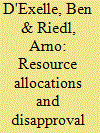

|
|
|
|
|
| Publication |
2013.
|
| Summary/Abstract |
Resources are often allocated in groups through decentralized nonmarket mechanisms. We experimentally investigate groups where a rich representative allocates resources among poorer members, who can announce disapproval by voting for a measure hurting the representative. We examine the effect of inequality aversion by keeping information on the allocation private in one and commonly known in another condition. Further, we investigate whether casting votes publicly or secretly influences allocation and voting behavior. We find that disapproval rates are highest with secret voting or a commonly known resource allocation. Disapproval voting fails to stimulate representatives to appear more prosocial, but rather induces them to keep everything. Private information on the allocation and public voting leads to least disapproval and exclusion of the poorest group members from the resources. The analysis shows that inequality aversion of poorer group members crucially interacts with the investigated institutional and informational details of the resource allocation situation.
|
|
|
|
|
|
|
|
|
|
|
|
|
|
|
|
|
|
|
|
|